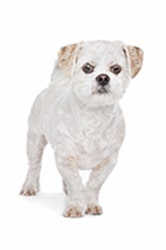Maltese Shih Tzu
-
Overview
The Maltese Shih Tzu is one of the most popular hybrid breeds that is not a Poodle mix, although they were bred with the same goal – to be adorable, lovable companion dogs with low-shedding coats.
-
Personality
This hybrid breed has absorbed many of the best traits of its parent breeds. As a result, they are gentle, affectionate dogs who love to be around people. They’re less driven to bark than other lap dogs. Maltese Shih Tzus are curious dogs who love to learn. They are less stubborn than their parent breeds, which makes them easier to train. These social dogs live to be around people. Whether they’re playing actively in a yard or relaxing indoors, they prefer to be accompanied by humans or other dogs, and won’t appreciate being left alone for long periods of time.
-
Coat Care
The Maltese Shih Tzu definitely has the genes for great hair. Their coats are long, silky and soft, just like their parent breeds. Although most of their coats are white, they also have tan, brown or black markings, and sometimes, their whole coats can appear in darker shades. Because their coats aren’t pure white, they are less prone to tearstaining. Maltese Shih Tzu’s faces should look like a mix of both breeds, with a slightly longer snout and without the Shih Tzu’s bulging eyes.

With long, silky coats on both sides of the family, Maltese Shih Tzus need to be brushed at least twice a week to prevent tangling and keep the coat shiny and smooth. A daily brushing is best.
Regular bathing helps keep their coats healthy, soft and tangle-free. Maltese Shih Tzus will be prone to tearstaining, so special attention to the areas around the eyes and ears will help keep them comfortable and prevent staining and infections.
Some owners choose to clip their Maltese Shih Tzus to make grooming easier, but with regular brushing, bathing and attention, clipping isn’t absolutely necessary any more than once every 6-9 weeks.
Many dog owners are apprehensive about trimming their dog’s nails because they are nervous about cutting into the quick. But with the right conditioning and careful cutting, nail clipping can be a simple, stress-free activity for you and your dog.
Provide your dog with plenty of positive reinforcement and even treats to help associate nail clipping with a positive experience. As you start to clip, gently press on your dog’s paws to help him become accustomed to the feeling of having his nails clipped. Then, work gradually, shaving down just a thin portion of the nail at first to make sure you don’t reach the quick. Clip one nail, reward your dog with a treat, and stop to give him some positive reinforcement before moving on. Gradually increase the number of nails you clip in one sitting to help your dog get used to the process. Never trim extremely long nails down to a short nail in one sitting, because this is an excellent way to accidently quick the dog’s nail. Instead, work gradually, shaving small portions of your dog’s nails off each time.
You can tell if you’re getting close to the quick by the texture of your dog’s nail. The nail is hard closer to the surface and becomes softer as you get closer to the quick. If your dog’s nail starts to feel softer, that’s a good indication that you’re getting close to the quick.
Not all breeds and coat styles require routine trimming in and around the eyes and ears but all should undergo regular inspection and cleaning around these sensitive areas. Doing so will help prevent the development of infections that could seriously damage these amazing organs.
It is always important to routinely clean your dog's eyes and ears, and examine for potential infections. Silky coated breeds often have hanging pendant ears covered in feathered hair, which means their ears need to be checked weekly for infection and cleaned with a cotton ball. Gently wipe a cotton ball moistened with mineral oil, olive oil or witch hazel in your dog's ear, being careful to avoid the ear canal. Never use a Q-Tip, which could cause damage to the inner ear if your dog suddenly shakes or jerks his head. Bushy hair growth within the ear can be thinned with tweezers or blunt scissors. Use a small trimmer to trim excess hair around the eyes, ears and face.
Many owners do not realize how important it is to brush your pet’s teeth on a regular basis. Some dogs are prone to dental problems and sensitive teeth, especially small dogs with tiny teeth and dogs with special diets. These problems can be easily combatted with frequent brushing.
Cavities are rare with dogs but gum disease caused by tartar buildup is not, which is why they require regular brushing with toothpaste and a toothbrush formulated specifically for dogs. While daily brushing is ideal, doing so on a weekly basis will be a big help in avoiding the need to bring your dog to a veterinarian for a cleaning, which usually has to be done under sedation.

 India (English)
India (English)
 Middle East and Africa (English)
Middle East and Africa (English)
 South Africa (English)
South Africa (English)
 Australia (English)
Australia (English)
 Japan (日本語)
Japan (日本語)
 South East Asia (English)
South East Asia (English)
 Singapore (English)
Singapore (English)
 Europe (English)
Europe (English)
 United Kingdom (English)
United Kingdom (English)
 Argentina (Español)
Argentina (Español)
 Brazil (Portuguese)
Brazil (Portuguese)
 Colombia (Español)
Colombia (Español)
 Latin America (Español)
Latin America (Español)
 México (Español)
México (Español)
 Chile (Español)
Chile (Español)
 Peru (Español)
Peru (Español)
 Canada (English)
Canada (English)

